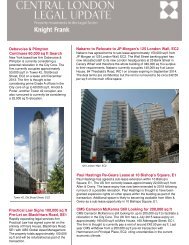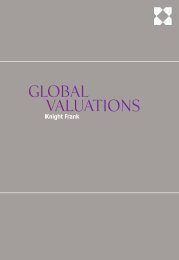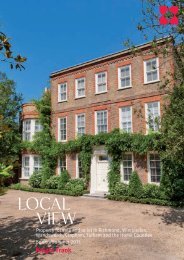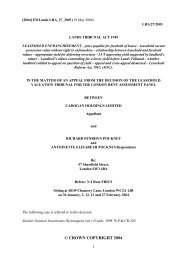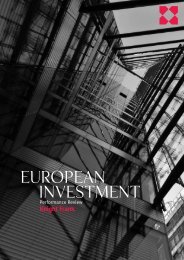40 Chelsea Square - Knight Frank
40 Chelsea Square - Knight Frank
40 Chelsea Square - Knight Frank
Create successful ePaper yourself
Turn your PDF publications into a flip-book with our unique Google optimized e-Paper software.
anything, too low, depends entirely on his assessment of the value of the rights granted by the<br />
Acts. In our judgement, if any conclusion can be drawn from this transaction at all, and we<br />
share Mr Shingles’ doubts as to this, it is that a conventional valuation of those rights almost<br />
certainly undervalues them.<br />
106. It is in this context that Mr Gibbs’ evidence of what he calls “uncorrupted sales evidence<br />
of houses”, by which he means purchases of reversions by tenants without the benefit of<br />
enfranchisement rights, is of potential value. The purchase of 52 Eaton Terrace from the<br />
Grosvenor Estate has the merit of being documented as to how the price was arrived at. In our<br />
judgement the willingness of the tenant to pay 75% of a marriage value calculated on the basis<br />
of a relativity between the leasehold and the freehold value, which is assumed to be lower than<br />
would appear on the John D.Wood/Gerald Eve (1996) graph of supposed relativities, merely<br />
shows that even on such basis the relative value of the leasehold interest is being<br />
overestimated. In our judgement the transaction does not justify analysis from which any<br />
conclusion as to the market yield from an investment in a reversion can properly be drawn.<br />
The mere fact that negotiation proceeded from what would have been paid under the Act, if the<br />
tenant had had enfranchisement rights under it, shows how completely the no-Act world has<br />
disappeared.<br />
107. In the other cases to which Mr Gibbs refers, 52 Cadogan Lane and 6 Tite Street, there is<br />
not even agreement as to the basis of the figures arrived at, and, as he accepted in cross-<br />
examination, one can by changing the assessment of relativity get any answer one may like.<br />
We do not feel able to derive any assistance from these transactions.<br />
108. Mr Orr-Ewing referred to the sale in about September 2002, of the rack rental income<br />
amounting to £142,500 per annum of premises at 16 Ovington <strong>Square</strong> SW3. Even if his<br />
analysis of the transaction had not been disputed by Mr Cullum, we do not think that the sale of<br />
such an income stream can be of assistance to us in arriving at a deferment rate as opposed to a<br />
capitalisation rate. For the same reason Mr Cullum’s own reference to transactions concerning<br />
3 Ennismore Gardens in March 2003 and Flats 7, 8 and 9, 14/15 Ennismore Gardens in<br />
February 2004, although having the advantage that they are concerned with ground rents rather<br />
than rack rents, are of no assistance in assessing the deferment rate as opposed to the<br />
capitalisation rate.<br />
109. We are grateful to the witnesses who have done their best to produce market evidence<br />
which might have been of assistance. Their failure to do so confirms us in the view that there<br />
is none and the circumstances which now exist make it virtually impossible that there can be<br />
any. The transactions to which we have been referred can be categorised as:-<br />
(i) sales in which excluded parties took part, either increasing the price or, where there<br />
would be a right of pre-emption, reducing it;<br />
(ii) sales where the result of analysis under the Act makes the resultant deferment rate a<br />
matter of circularity, when the probable proper conclusion is that the value of the<br />
statutory right has been underestimated;<br />
(iii) sales driven not by the value of the reversion, if any, but by the income stream.<br />
24



